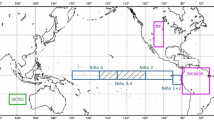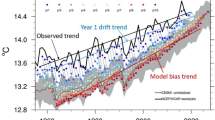Abstract
In the recent decade, operational seasonal prediction systems based on initialized coupled models have been developed. An analysis of how the predictability of seasonal means in the initialized coupled predictions evolves with lead-time is presented. Because of the short lead-time, such an analysis for the temporal behavior of seasonal predictability involves a mix of both the predictability of the first and the second kind. The analysis focuses on the lead-time dependence of ensemble mean variance, and the forecast spread. Further, the analysis is for a fixed target season of December–January–February, and is for sea surface temperature, rainfall, and 200-mb height. The analysis is based on a large set of hindcasts from an initialized coupled seasonal prediction system. Various aspects of predictability of the first and the second kind are highlighted for variables with long (for example, SST), and fast (for example, atmospheric) adjustment time scale. An additional focus of the analysis is how the predictability in the initialized coupled seasonal predictions compares with estimates based on the AMIP simulations. The results indicate that differences in the set up of AMIP simulations and coupled predictions, for example, representation of air–sea interactions, and evolution of forecast spread from initial conditions do not change fundamental conclusion about the seasonal predictability. A discussion of the analysis presented herein, and its implications for the use of AMIP simulations for climate attribution, and for time-slice experiments to provide regional information, is also included.









Similar content being viewed by others
References
Barnston AG, Kumar A, Goddard L, Hoerling MP (2005) Improving seasonal predictions practices through attribution of climate variability. Bull Am Meteor Soc 85:59–72
Chang Y, Schubert SD, Suarez M (2000) Boreal winter predictions with the GEOS-2 GCM: the role of boundary forcing and initial conditions. Q J Roy Meteor Soc 126:2293–2322
Chen D, Cane MA, Kaplan A, Zebiak SE, Huang D (2004) Predictability of El Niño over 148 years. Nature 428:733–736
Chen M, Wang W, Kumar A (2009) Prediction of monthly mean temperature: the roles of atmospheric and land initial condition and sea surface temperature. J Clim, to appear
Gadgil S, Joseph PV, Joshi NV (1984) Ocean–atmosphere coupling over monsoon regions. Nature 312:141–143
Harzallah A, Sadourny R (1995) Internal versus SST-forced variability as simulated by an atmospheric general circulation model. J Clim 8:474–495
Hoerling MP, Kumar A (2002) Atmospheric response patterns associated with tropical forcing. J Clim 15:2184–2203
Hoerling MP, Kumar A, Eischeid J, Jha B (2008a) What is causing the variability in Global Land Temperature? Geophys Res Lett 35:L23712. doi:10.1029/2008GL035984
Hoerling M, Hegerl G, Karoly D, Kumar A, Rind D (2008b) Attribution of the causes of climate variations and trends over North America during the modern reanalysis period. In: Dole R, Hoerling M, Schubert S (eds) Reanalysis of historical climate data for key atmospheric features: implications for attribution of causes of observed change. A report by the U.S. Climate Change Science Program and the Subcommittee on Global Change Research. National Oceanic and Atmospheric Administration, National Climatic Data Center, Asheville, NC, pp 47–92
Jha B, Kumar A (2008) A comparison of the atmospheric response to ENSO in coupled and uncoupled model simulations. Mon Wea Rev 137:479–487
Jha B, Kumar A (2009) A comparative analysis of change in the first and second moment of the PDF of seasonal mean 200-mb heights with ENSO SSTs. J Clim 22:1412–1423
Jin F-F, Hoskins BJ (1995) The direct response to tropical heating in a baroclinic atmosphere. J Atmos Sci 52:307–319
Jin E et al (2008) Current status of ENSO prediction skill in coupled ocean-atmosphere models. Clim Dyn 31:647–664. doi: 10.1007/s00382-008-0397-3
Kanamitsu M, Ebisuzaki W, Woolen J, Yang S-K, Hnilo J, Fiorino M, Potter GL (2002) NCEP–DOE AMIP-II Reanalysis (R-2). Bull Am Meteor Soc 83:1631–1643
Kug J-S, Kang I-S, Choi D-H (2008) Seasonal climate predictability with tier-one and tier-two prediction systems. Clim Dyn 31:403–416
Kumar A, Hoerling MP (1995) Prospects and limitations of seasonal atmospheric GCM predictions. Bull Am Meteor Soc 76:335–345
Kumar A, Hoerling MP (1997) Interpretation and Implications of the observed inter-El Niño variability. J Clim 10:83–91
Kumar A, Schubert SD, Suarez MS (2003) Variability and predictability of 200-mb seasonal mean heights during summer and winter. J Geophys Res 108:4169. doi:10.1029/2002JD002728
Kumar A, Jha B, Zhang Q, Bounoua L (2007) A new methodology for estimating the unpredictable component of seasonal atmospheric variability. J Clim 20:3888–3901
Kumar A, Zhang Q, Schemm J-KE, L’Heureux ML, Seo K-H (2008) An assessment of errors in the simulation of atmospheric interannual variability in uncoupled AGCM simulations. J Clim 21:2204–2217
Kusunoki S, Sugi M, Kitoh A, Kobayashi C, Takano K (2001) Atmospheric seasonal predictability experiments by the JMA AGCM. J Meteor Soc Jpn 79:1183–1206
Lorenz EN (1969) The predictability of a flow which possesses many scales of motion. Tellus 21:289–307
Luo J-J, Masson S, Behera S, Shingu S, Yamagata T (2005) Seasonal climate predictability in a coupled OAGCM using a different approach for ensemble forecasts. J Clim 18:4474–4497
Luo J-J, Masson S, Behera S, Yamagata T (2008) Extended ENSO predictions using a fully coupled ocean-atmosphere model. J Clim 21:84–93
Meehl GA et al (2009) Decadal prediction: can it be skillful. Bull Am Meteor Soc 90:1467–1485
Newman M, Sardeshmukh PD (1998) The impact of the annual cycle on the North Pacific/North American response to remote low-frequency forcing. J Atmos Sci 55:1336–1353
Palmer TN et al (2004) Development of a European multi-model ensemble system for seasonal to interannual prediction (DEMETER). Bull Am Meteor Soc 85:853–872
Peng P, Kumar A, Barnston AG, Goddard L (2000) Simulation skills of the SST-forced global climate variability of the NCEP–MRF9 and the Scripps–MPI ECHAM3 models. J Clim 13:3657–3679
Phelps MW, Kumar A, O’Brien JJ (2004) Potential predictability in the NCEP/CPC dynamical seasonal forecast system. J Clim 17:3775–3785
Reynolds RW, Rayner NA, Smith TM, Stokes DC, Wang W (2002) An improved in situ and satellite SST analysis for climate. J Clim 15:1609–1625
Rowell DP (1998) Assessing potential seasonal predictability with an ensemble of multidecadal GCM simulations. J Clim 11:109–120
Saha S et al (2006) The NCEP climate forecast system. J Clim 19:3483–3517
Shukla J et al (2000) Dynamical seasonal prediction. Bull Am Meteor Soc 81:2593–2606
Tang Y, Debg Z, Zhou Z, Cheng Y, Chen D (2008) Interdecadal variation of ENSO predictability in multiple models. J Clim 21:4811–4833
Trenberth EK, Branstrator GW, Karoly D, Kumar A, Lau N-C, Ropelewski C (1998) Progress during TOGA in understanding and modeling global teleconnections associated with tropical sea surface temperatures. J Geophys Res 103(C7):14291–14324
van den Dool HM, Peng P, Johansson A, Chelliah M, Shabbar A, Saha S (2006) Seasonal-to-decadal predictability and prediction of North American climate—the Atlantic influence. J Clim 19:6005–6024
Wang W, Saha S, Pan H-L, Nadiga S, White G (2005) Simulation of ENSO in the new NCEP Coupled Forecast System Model (CFS03). Mon Wea Rev 133:1574–1593
Wang B et al (2008) How accurately do coupled models predict the leading modes of Asian-Australian monsoon interannual variability? Clim Dyn 30:605–619
Weigel AP, Baggenstos D, Liniger M, Vitart F, Appenzeller C (2008) Probabilsitic verifcaiton of monthly temperature forecasts. Mon Wea Rev 136:5152–5182
Xie P, Arkin PA (1997) Global precipitation: a 17-year monthly analysis based on gauge observations, satellite estimates, and numerical model outputs. Bull Am Meteor Soc 78:2539–2558
Zwiers FW, Wang XL, Sheng J (2000) Effects of specifying boundary conditions in an ensemble of atmospheric GCM simulations. J Geophys Res 105:7295–7315
Acknowledgments
Constructive comments by two anonymous reviewers and by Drs. M. Chelliah and Hui Wang greatly improved the final version of the manuscript.
Author information
Authors and Affiliations
Corresponding author
Rights and permissions
About this article
Cite this article
Peng, P., Kumar, A. & Wang, W. An analysis of seasonal predictability in coupled model forecasts. Clim Dyn 36, 637–648 (2011). https://doi.org/10.1007/s00382-009-0711-8
Received:
Accepted:
Published:
Issue Date:
DOI: https://doi.org/10.1007/s00382-009-0711-8




